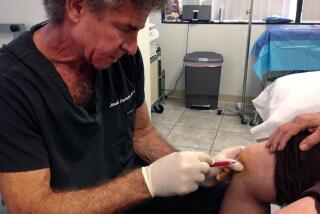Research firm reaped stem cell funds despite panel’s advice
StemCells Inc. has a history not much different from those of dozens, even hundreds, of biotech companies all around California.
Co-founded by an eminent Stanford research scientist, the Newark, Calif., firm has struggled financially while trying to push its stem cell products through the research-and-development pipeline. It collects about $1 million a year from licensing patents and selling cell cultures but spends well more than $20 million annually on R&D;, so it runs deeply in the red.
On the plus side, StemCells Inc. has had rather a charmed relationship with the California stem cell program, that $3-billion taxpayer-backed research fund known formally as the California Institute for Regenerative Medicine.
The firm ranks first among all corporate recipients of approved funding from CIRM, with some $40 million in awards approved this year. That’s more than has gone to such established California nonprofit research centers as Cedars-Sinai Medical Center, the Salk Institute for Biological Studies, and the Sanford-Burnham Medical Research Institute.
The record of StemCells is particularly impressive given that one of the two proposals for which the firm received a $20-million funding award, covering a possible Alzheimer’s treatment, was actually rejected by CIRM’s scientific review panel — twice. Nevertheless, the stem cell agency’s governing board went ahead and approved it last month.
What was the company’s secret? StemCells says it’s addressing “a serious unmet medical need” in Alzheimer’s research. But it doesn’t hurt that the company also had powerful friends going to bat for it, including two guys who were instrumental in getting CIRM off the ground in the first place.
There’s nothing improper about the state stem cell agency funding private enterprise; that’s part of its statutory duties, and potentially valuable in advancing the goals of research. In part that’s because CIRM is in a good position to help biotech firms leapfrog the “valley of death” — the territory between basic research and the much more expensive and speculative process of moving a technology to clinical testing and, hopefully, the marketplace. Unfortunately, that’s also the point where outside investment often dries up.
But private enterprise is new territory for CIRM, which has steered almost all its grants thus far to nonprofit institutions. Those efforts haven’t been trouble-free: With some 90% of the agency’s grants having gone to institutions with representatives on its board, the agency has long been vulnerable to charges of conflicts of interest. The last thing it needed was to show a similar flaw in its dealings with private companies too.
That brings us back to StemCells Inc. First, consider the firm’s pedigree. Its co-founder was Irving Weissman, director of Stanford’s Institute for Stem Cell Biology and Regenerative Medicine and a stem cell research pioneer. Weissman was one of the most prominent and outspoken supporters of Proposition 71, the 2004 ballot initiative that established the stem cell agency.
He’s also been a leading beneficiary of CIRM funding, listed as the principal researcher on three grants worth a total of $24.5 million. The agency also contributed $43.6 million toward the construction of his institute’s glittering $200-million research building on the Stanford campus. As of mid-April Weissman was still listed as a shareholder of StemCells, where his wife, Ann Tsukamoto, is an executive. Weissman, who is traveling in Africa, could not get back to me by deadline to talk about his relationship with the company.
Then consider the unusual path to the company’s $40 million in funding. The funds technically are interest-bearing loans, but they’re more like grants — they can be forgiven if the research they support fails to get commercialized; even if the project is successful, CIRM isn’t guaranteed full recovery.
In July, the board approved one $20-million award to StemCells for therapies for spinal cord injury. But the second $20-million application hit a snag. It covered a means of transplanting healthy stem cells into one part of the brain in the expectation that they would migrate and repair Alzheimer’s-damaged cells throughout the organ. The existing research was in mice, and the scientific reviewers weren’t convinced that the theory was applicable to humans or that it would be commercially feasible. They recommended rejection.
Then came the push-back. On the governing board’s agenda for its July 26 meeting was StemCells’ appeal of the rejection. And the appeal had a surprising supporter: Bob Klein.
Klein is the Northern California real estate man who drafted Proposition 71, headed the ballot campaign and served until last year as the first chairman of the agency’s governing board. In California stem cell circles, his prestige is immense. And the fact that his advocacy for StemCells was his first such appearance before the board since his departure surely gave it a special zing.
Klein’s pitch was that StemCells was about to publish in a peer-reviewed journal new data validating its Alzheimer’s approach. The board duly sent the application back to the scientific review panel for another look.
The review panel looked over the new information — and recommended rejection again. Its members observed that the new data offered by the company hadn’t actually been accepted by the peer-reviewed journal, which had requested “major revisions” before considering it for publication.
When the matter came before the governing board a second time on Sept. 5, however, StemCells had a new pitch. It would match CIRM’s $20 million with $20 million of its own. Klein was again on hand to make its case. “This is $20 million of company money betting on their science,” he said. He called StemCells “the best company with the most experience” and labeled its proposal “the best shot that I saw for advancing Alzheimer’s research.”
Klein told me via email that he has no financial interest in StemCells Inc., or indeed in any biotech or stem cell companies. In a written statement provided to David Jensen of the authoritative California Stem Cell Report, he said he appeared before the board as a “patient advocate.”
But he’s not your average “patient advocate.” His appearance before the board led to complaints by some board members about “lobbying” and “politicking” and “friends” calling friends.
Board member Jeff Sheehy, a communications officer at UC San Francisco, told me he thought Klein’s advocacy put some board members in “a very difficult situation.... It felt like lobbying.” At a subsequent board meeting, Sheehy called it “arm twisting.”
In any case, after Klein’s second appeal the agency board overruled the scientific panel and approved the award — with a condition proposed by Governing Board Chairman Jonathan Thomas that StemCells show it has the matching funds before it can touch CIRM’s money. None of the members voting in favor acknowledged being swayed by Klein, but some of their arguments resembled his, including that even if the project is speculative, it may be the best chance of finding a therapy for a disease against which little progress has been made; and that it is showing its confidence by pledging matching funds.
But that merely opens another can of worms. The problem is that StemCells doesn’t have $20 million in spare funds. Its quarterly report for the period ended June 30 listed about $10.4 million in liquid assets, and shows it’s burning about $5 million per quarter. Its prospects of raising significant cash from investors are, shall we say, conjectural.
As it happens, within days of the board’s vote, the firm downplayed any pledge “to raise a specific amount of money in a particular period of time.” The idea that CIRM “is requiring us to raise $20 million in matching funds” is a “misimpression,” it said. Indeed, it suggested that it might count its existing spending on salaries and other “infrastructure and overhead” as part of the match. StemCells declined my request that it expand on its statement.
CIRM spokesman Kevin McCormack says the agency is currently scrutinizing StemCells’ finances “to see what it is they have and whether it meets the requirements and expectations of the board.” The goal is to set “terms and conditions that provide maximum protection for taxpayer dollars.” He says, “If we can’t agree on a plan, the award will not be funded.” He called that “a normal process.”
But as Thomas observed, StemCells’ financial dependence on CIRM isn’t normal. And for the agency to accept a company’s pledge of “matching funds” without determining in advance what is meant by the term shouldn’t be normal. CIRM’s guidelines for corporate research applications “encourage” for-profit applicants to find other sources of funding to “leverage” CIRM funds.
That’s important, because CIRM’s funds aren’t limitless; it has already committed more than half its $3-billion hope chest. But the agency shouldn’t be deciding on the spot what does or doesn’t qualify as matching funds. It should have clear guidelines in advance.
Nor should the board overturn the judgment of its scientific review panels without clear-cut reasons. A board committee is working on tighter standards for appeals, but the record suggests that the handling of the StemCells appeal was at best haphazard and at worst redolent of cronyism.
Michael Hiltzik’s column appears Sundays and Wednesdays. Reach him at [email protected], read past columns at latimes.com/hiltzik, check out facebook.com/hiltzik and follow @latimeshiltzik on Twitter.
More to Read
Inside the business of entertainment
The Wide Shot brings you news, analysis and insights on everything from streaming wars to production — and what it all means for the future.
You may occasionally receive promotional content from the Los Angeles Times.











